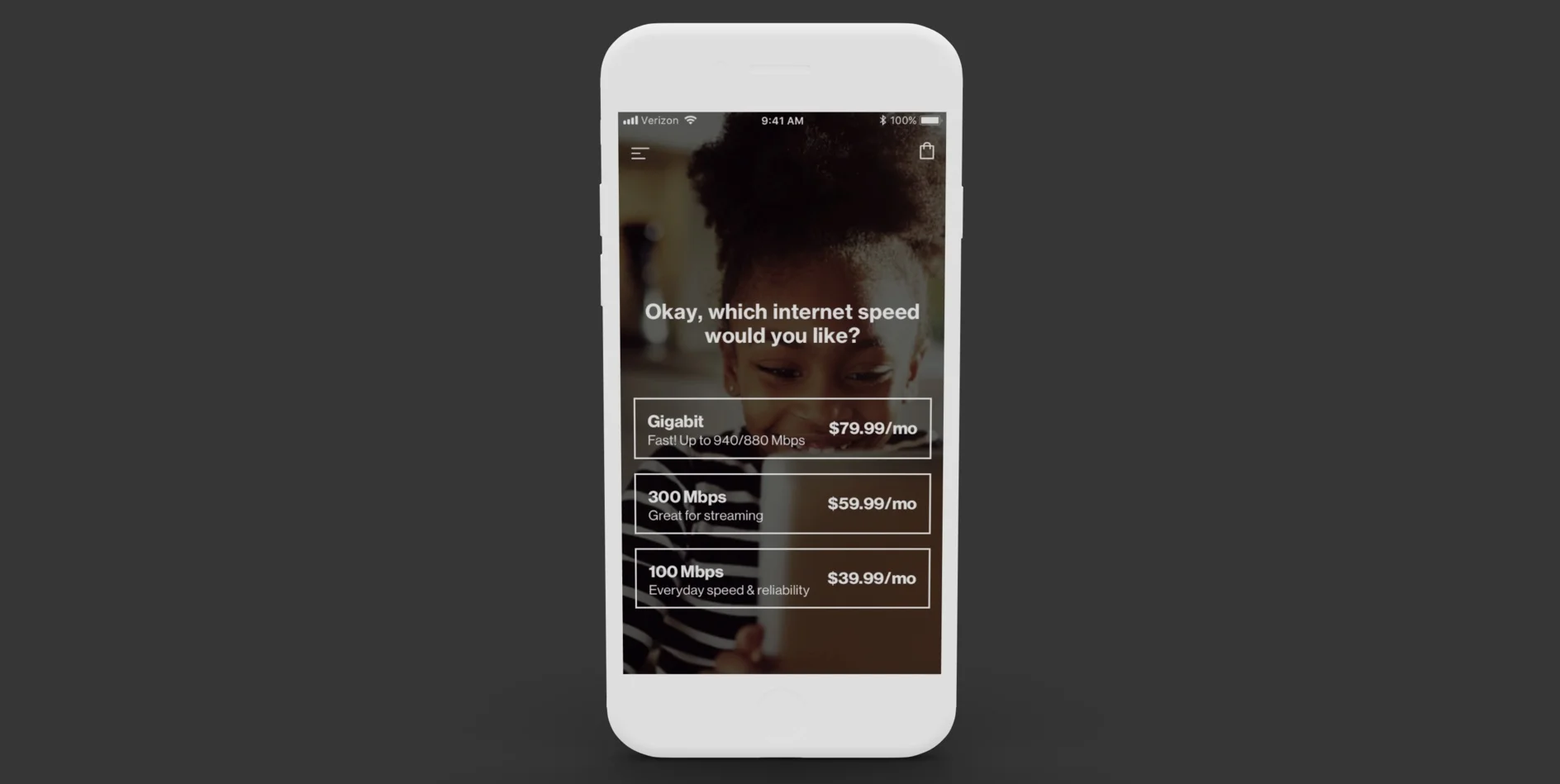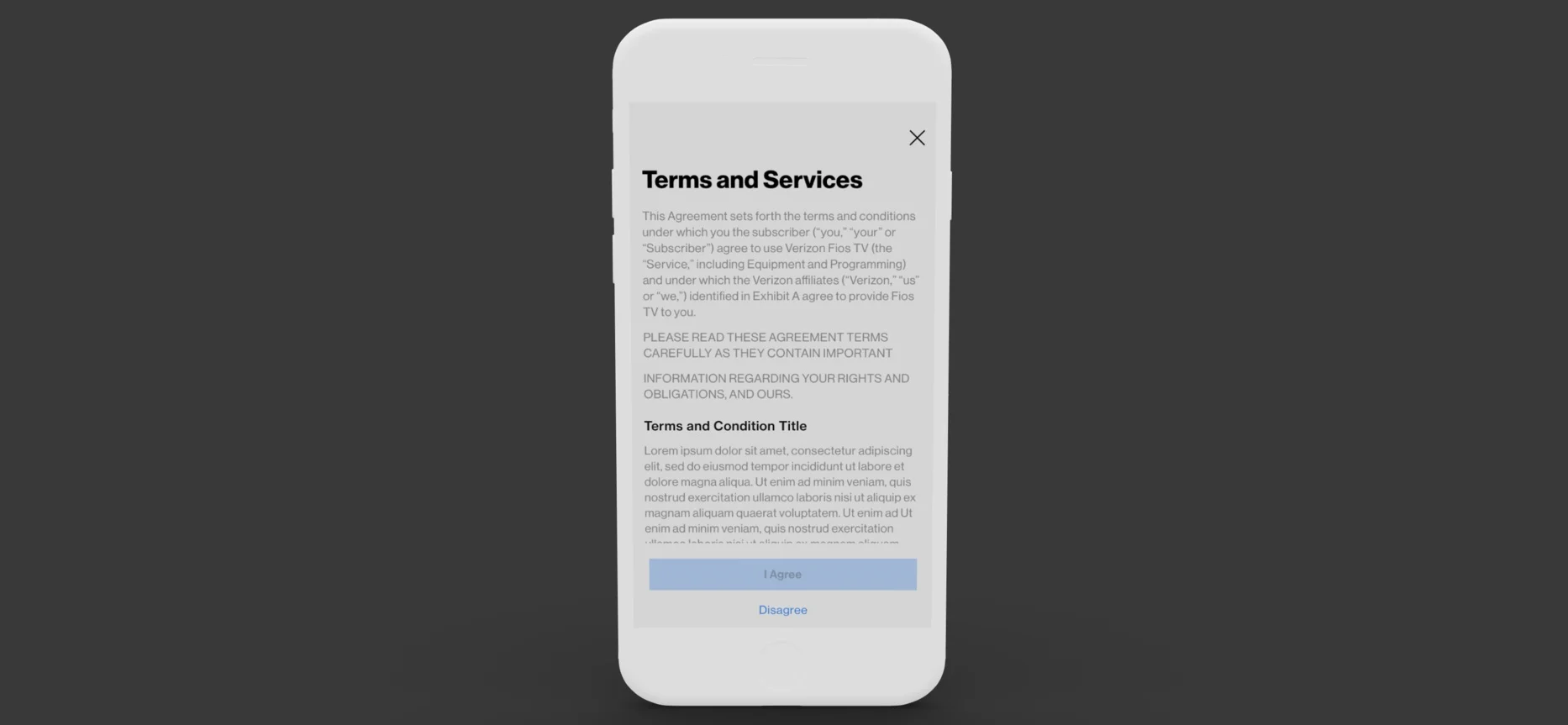OVERVIEW
The Challenge: How can we simplify complex sales transactions for quick ordering on a mobile platform?
Timeline: 9 months
Role: UX Researcher / UX Designer / UI Designer
Tools: Pen & paper / Whiteboard / Sketch / InVision Lucidchart / Principle / Google Drive / Google Slides
Verizon Fios is a global leader delivering innovative communications and technology solutions that improve the way our people live, work, learn and play.
Project: I was part of a Fios CX Design team that worked on an NDA project called ‘Unify’. The goal was to create a simple and intuitive way to combine wireless and wireline ordering. Through that exploration came a conversational platform.
Platform: Mobile (iOS & Android)
THE PROCESS
DISCOVERY
Human connection is what we do best.
Inspiration from within.
When someone orders Fios on the phone or door-to-door agents come to your home or you’re in the store speaking with retail staff, having those conversations are invaluable. Those conversations are the reason why Verizon has won many awards for its customer service. What better way to model this new product after.
Why Conversational?
What’s a conversational interface?
A conversational interface is any UI that mimics chatting with a real human.
Why for the project ‘Unify’?
Messaging ranks #1 as the preferred communication channel around the world.*
Verizon Chatbot had received much success.
We found a guided conversation was a more rewarding user experience in this context.
*Credit: Twilio
How Might We…
Every problem is an opportunity for design. By framing our challenges as a How Might We question, we were aiming to set ourselves up for an innovative solution.
Design
HMW make ordering Fios quick and simple
HMW guide the customer through the process
HMW educate and inform the customer
Visual Design
HMW create a compelling digital experience for our customers
HMW tell a narrative through the experience
Scale
HMW apply this structure to every other business transaction
HMW scale this to voice
Build A Strategy
This CX strategy helped us fulfill Verizon’s customer-centric business mission.
Research
Comparative Analysis
OVERALL FINDINGS
Most common features:
Simplification of information
Conversational copy
Modular components allow for scalability
Personalized, relevant content
Contextual Research
In Store Experience
We wanted to research how someone shops for technology. So we went to Apple, Microsoft and Verizon stores. Contextual research is going out to a natural user environment and observing behavior or asking questions to find out more about your customers, their motivations and how they may experience the store. It’s unique in that it puts us in the user environment, rather than bringing the user into our environment.
Main Takeaways:
Let the user browse the products and ask questions
Ask relevant personal questions to understand the usage and intent of the user
Speak the user’s language; explain technology so the user can understand
User Journey Map
This user journey is inspired by real life. We wrote a conversation a person might have with a call center rep.
The sample script below.
Design Studio
We started by exploring various possible solution paths. We compared a series of quickly sketched possibilities.
Our goals..
Guided experience
Simplicity
Bite-size information for the user
DELIVER
Wireframes
We started with low fidelity paper wireframes then quickly moved to medium fidelity wireframes for testing. Low fidelity paper wireframes were not as detailed for the users which left room for confusion. Therefore, we moved to high fidelity wireframes and our feedback significantly improved & influenced our design iterations.
Prototype
Tested the wireframes first then the prototypes for finalization.
Participants: 8 participants; aged 18-65+; mix of gender
Unify on-boarding screens
SCENARIO
In today's test, imagine you want to purchase internet. The company has an app that you’ve downloaded. It allows you to schedule an appointment for service.
Tasks
You like watching Youtube, which speed would you choose?
How would you purchase a router?
You’d like to schedule an appointment on March 21 at 5pm.
Before you place your order, change your speed to the fastest. Also, now let’s pay monthly for your router.
Results
Plan selection: Folks wanted more details on the different plans. There wasn’t enough information. What were the differences?
Credit check: Millennials were ok with a credit check however, older adults did not want to participate.
Terms of service [TOS]: Many thought this took too long to load. Instead, they would prefer an email of TOS to read at their leisure.
Installation calendar: This was a winner. Only 1 out of 7 wanted the font to be bigger.
Review page (change/update your plan): Edit options were clear. Users understood.
Scroll down for CTA
What I learned
Simplicity is a fundamental design principle. The easier something is to understand and use – the more likely it is to be adopted and engaged with. Throughout the UX process, I tried to keep the functionality of the final design simple. However, the users had problems with the animation of the text. One pain point was when a person was distracted and did not notice the messages; they were lost in the flow and unsure what they saw or why. This needs to be addressed, as we need to give the users more control over what they see and how they want to see it. We will continue to refine the design.
Impact
Conversational design was crucial to its success. I played a multifaceted role in elevating the visibility of our small Lean Team, which consists of front-end developers and a CX designer. Through my input, we were able to effectively showcase our expertise and capabilities in conversational design, which positioned us as leaders in the field. Additionally, as a result of our efforts, we were granted two patents.
Our work had a lasting impact on the team members involved. During the transition to the wireless sector of Verizon business, a subset of our team continued to develop the VZ Assistant. Our groundwork and innovative approach provided a solid foundation for continued growth and success in this new endeavor.






















